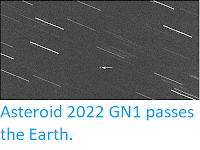Asteroid 2022 JK passed by the Earth at velocity of km per second and a distance of about 411 400
km (1.01 times the average distance between the Earth and the Moon, or
0.28% of the distance between the Earth and the Sun), slightly before 1.45 am
GMT on Tuesday 3 May 2022. There was no danger of
the asteroid hitting us, though were it to do so it would not have
presented a significant threat. 2022 JK has an estimated
equivalent
diameter of 9-27 m (i.e. it is estimated that a spherical object
with
the same volume would be 9-27 m in diameter), and an object of this
size
would be expected to explode in
an airburst (an explosion caused by superheating from friction with the
Earth's atmosphere, which is greater than that caused by simply
falling, due to the orbital momentum of the asteroid) between 35 and 20 km above the ground, with only fragmentary material
reaching the Earth's surface.

2022 JK was discovered on 3 May 2022 (the day of its closest encounter with the Earth) by the University of Tokyo's Kiso Observatory. The designation 2022 JK
implies that the asteroid was the tenth object (asteroid K -
in numbering asteroids the letters A-Z, excluding I, are assigned
numbers from 1 to 25, with a number added to the end each time the
alphabet is ended, so that A = 1, A1 = 26, A2 = 51, etc., which means that K = 10) discovered in the first half of May 2022 (period 2022 J - the
year being split into 24 half-months represented by the letters A-Y, with I being excluded).

2022 JK is calculated to have a 1494 day (4.09 year) orbital period, with an elliptical
orbit tilted at
an angle of 0.82° to the plain of the Solar System which takes in to
0.59 AU from the Sun (59% of the distance at which the Earth orbits the
Sun, and inside the orbit of the planet Venus) and out to 4.53 AU (4.53 times the distance at which the Earth orbits
the Sun, and more than three times the distance at which the planet Mars orbits). It is therefore classed as
an Apollo Group Asteroid (an asteroid that is on average further from the Sun
than the Earth, but which does get closer). This means that 2022 JK has occasional close
encounters with the Earth, with the
last thought to have happened in November 1976. The asteroid also has occasional close encounters with the planet Jupiter, with the last thought to have happened in December 1961 and the next predicted for March 2033.
See also...



Follow Sciency Thoughts on Facebook.
Follow Sciency Thoughts on Twitter.






































